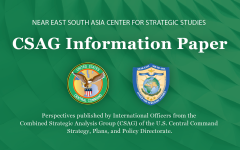Deterring the “Exquisite Diplomat”: Unpacking the Complexities of U.S.-Iran Deterrence Dynamics
July 15, 2024 2024-07-15 16:15Deterring the “Exquisite Diplomat”: Unpacking the Complexities of U.S.-Iran Deterrence Dynamics
Deterring the “Exquisite Diplomat”: Unpacking the Complexities of U.S.-Iran Deterrence Dynamics
CSAG STRATEGY PAPER
CDR Hubert Mróz, Polish Navy (CSAG/CCJ5), COL Sayed Mohammed, Egyptian Army (CSAG/CCJ5), and LTC Rene Berendsen, Royal Netherlands Army (CSAG/CCJ5)
8 July 2024
Introduction:
The effectiveness of U.S. deterrence against Iran and its allies varies across different realms of power. In the military realm, the U.S., particularly through CENTCOM, has been relatively successful in deterring Iran. However, in other realms like diplomacy and economics, it is Iran that seems to be deterring rather than being deterred. During his testimony to Congress, USCENTCOM Commander, General Kurilla, stated that the key to establishing deterrence with Iran is ensuring there are consequences for their actions. He highlighted a specific instance where the U.S. conducted an attack against 85 targets, including killing the Kata’ib Hezbollah commander for Syria, al-Saadi. This action sent a strong deterrent message, resulting in no attacks in Iraq and Syria for 32 days. At the same time, General Kurilla emphasized that while deterrence can be effective, it is temporary in nature. “Iran never won a war, but never lost a negotiation!” was tweeted by former President Donald Trump on January 3, 2020. This statement reflects the perception of the regime in Tehran as an exquisite diplomat who has found a way to evade sanctions, maintain a strong position in the region, and stretch its influence and activities globally.
At the same time, the government in Tehran has developed its own highly effective deterrence mechanism via plausible deniability and diplomacy of terror. This paper discusses the interplay between Iran’s nuclear ambiguity, its ability to circumvent economic sanctions, and the perception of the Iranian threat by regional countries. It argues that these factors, combined with the varied success of U.S. deterrence across different realms of power, contribute to the challenges faced by the U.S. in deterring Iran effectively. The paper is organized in a way to explore the evolution of U.S. deterrence towards Iran, the effectiveness and the challenges of U.S. deterrence, and how Iran is countering U.S. deterrence.
Key Points:
- The U.S. has had varying degrees of success in deterring Iran and its allies across the elements of national power.
- The U.S. deterrence strategies towards Iran have evolved over time, reflecting the shifting priorities and approaches of successive administrations.
- There are several reasons why the effectiveness of the U.S. deterrence efforts can be questioned.
- There are parallels between the U.S. deterrence strategies against Iran and the USSR.
- Iran is deterring the U.S. as well.
View other USCENTCOM Combined Strategic Analysis Group (CSAG) papers here.
The opinions and conclusions expressed herein are those of a number of international officers within the Combined Strategic Analysis Group (CSAG) and do not necessarily reflect the views of United States Central Command, not of the nations represented within the CSAG or any other governmental agency.



